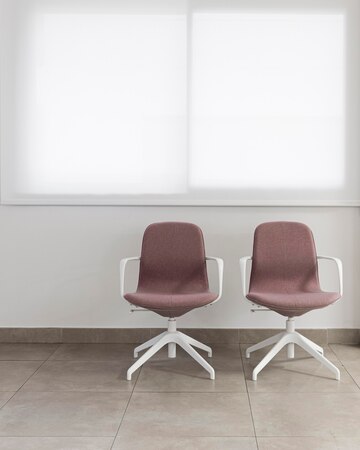For decades, office workers have grappled with the discomfort and health risks associated with prolonged sitting.
Early solutions came in the form of simple, upright chairs offering minimal support.
However, the field of ergonomics has revolutionized the way we approach seating, leading to the development of increasingly sophisticated ergonomic office chairs.
Let’s embark on a journey through time, exploring the evolution of ergonomic chair technology and how it has transformed our working experience.
Traditional Designs: Basic Comfort and Support
Traditional ergonomic chairs focused on basic comfort and support features. They typically had a simple design with a cushioned seat, backrest, and armrests. These chairs aimed to provide a level of comfort for office workers spending long hours sitting at their desks.
However, their ergonomic features were limited compared to modern designs. They lacked adjustable lumbar support, dynamic movement mechanisms, and advanced materials like mesh fabrics or memory foam cushions. This limitation often resulted in discomfort and increased risk of musculoskeletal issues among users, highlighting the need for innovation in ergonomic chair technology.
Early ergonomic chairs prioritized adjustable seat height and backrest tilt to accommodate different body sizes and sitting postures. While they offered some level of support, they lacked advanced features such as adjustable lumbar support, seat depth adjustment, and dynamic movement mechanisms.
Advanced Ergonomic Features
As the understanding of ergonomics improved, ergonomic chair designs began incorporating advanced features to enhance comfort and support. Adjustable lumbar support became a standard feature, allowing users to customize the chair’s back support to fit their spine’s natural curvature. Seat depth adjustment was also introduced to accommodate varying leg lengths and promote proper sitting posture.
These advancements revolutionized the ergonomic chair industry, leading to a significant reduction in back pain and discomfort among office workers. Additionally, the introduction of adjustable armrests, headrests, and tilt mechanisms further contributed to ergonomic excellence in modern chair designs.
Dynamic movement mechanisms, such as synchro-tilt and multi-functional tilt, were integrated into ergonomic chairs to encourage active sitting. These mechanisms allow the chair to tilt and move with the user’s body, reducing pressure points and promoting blood circulation. Adjustable armrests with padding and width adjustments further enhanced comfort and arm support during work activities.
Integration of High-Tech Materials
The evolution of ergonomic chair technology also involved the integration of high-tech materials for enhanced durability, comfort, and aesthetics. Mesh fabrics became popular for chair seats and backrests due to their breathability and ability to distribute weight evenly. Mesh chairs offer better airflow, keeping users cool and comfortable during prolonged sitting periods.
Additionally, the use of eco-friendly and sustainable materials in ergonomic chair manufacturing has gained traction, reflecting a growing awareness of environmental impact and sustainability in the furniture industry. Manufacturers are exploring innovative materials that combine durability, comfort, and eco-consciousness to meet the demands of modern consumers.
Additionally, ergonomic chairs started incorporating memory foam and gel-infused cushions for improved comfort and pressure relief. These materials conform to the body’s contours, reducing strain on the back, buttocks, and thighs. Leather and faux leather upholstery remained popular choices for executive-style ergonomic chairs, adding a touch of elegance to modern office spaces.
Ergonomic Chairs with Smart Features
The latest evolution in ergonomic chair technology includes the integration of smart features and connectivity options. Some high-tech ergonomic chairs come equipped with built-in sensors and monitoring systems that track sitting posture, movement patterns, and sitting duration. These chairs provide real-time feedback and reminders to encourage healthy sitting habits and posture correction.
Wireless connectivity allows users to adjust chair settings, such as seat height, lumbar support, and recline angle, through mobile apps or voice commands. Some chairs even offer massage and heat therapy functions to alleviate muscle tension and improve overall comfort. These smart features cater to the growing demand for wellness-focused office furniture in modern work environments.
Sustainable and Eco-Friendly Designs
In response to environmental concerns, the evolution of ergonomic chair technology also includes sustainable and eco-friendly designs. Manufacturers are using recycled materials, eco-friendly fabrics, and low-emission manufacturing processes to reduce their environmental footprint. Certifications such as GREENGUARD and Cradle to Cradle signify a commitment to sustainability and healthier indoor air quality.
Ergonomic chairs with modular components and replaceable parts are designed for longevity and ease of maintenance, reducing waste and promoting a circular economy. These sustainable practices align with the growing trend of eco-consciousness in the furniture industry and appeal to environmentally-conscious consumers and businesses.
Customization and Personalization Options
Modern ergonomic chairs offer extensive customization and personalization options to cater to individual preferences and ergonomic needs. Users can choose from a variety of chair sizes, colours, upholstery materials, and ergonomic features to create a chair that suits their unique requirements. Adjustable lumbar support, seat depth, armrests, and headrests ensure a tailored fit for optimal comfort and support.
Some manufacturers even offer custom-made ergonomic visitor chairs with precise measurements and ergonomic assessments to address specific ergonomic issues or medical conditions. This level of customization enhances user satisfaction and contributes to a healthier and more productive work environment.
Future Trends and Innovations
Looking ahead, the evolution of ergonomic chair technology is expected to continue with advancements in materials, design, and functionality. Innovations such as AI-powered posture correction systems, 3D-printed ergonomic chairs, and biometric sensing technology are on the horizon. These advancements aim to further enhance user comfort, wellness, and productivity in the workplace.
The integration of sustainable materials and circular design principles will also play a significant role in shaping the future of ergonomic chairs. Manufacturers will focus on creating products that promote well-being, reduce environmental impact, and adapt to evolving work trends, such as remote and hybrid work models.
Conclusion
In conclusion, the evolution of ergonomic chair technology has transformed the way we approach seating in the workplace. From basic comfort to high-tech solutions, ergonomic chairs have become essential tools for promoting health, productivity, and well-being. Embracing ergonomic excellence involves understanding the latest trends, selecting chairs with advanced features, and prioritizing comfort and support in office environments. As technology continues to advance, office visitor chairs will continue to evolve, ensuring a more comfortable and ergonomic future for office workers worldwide.




